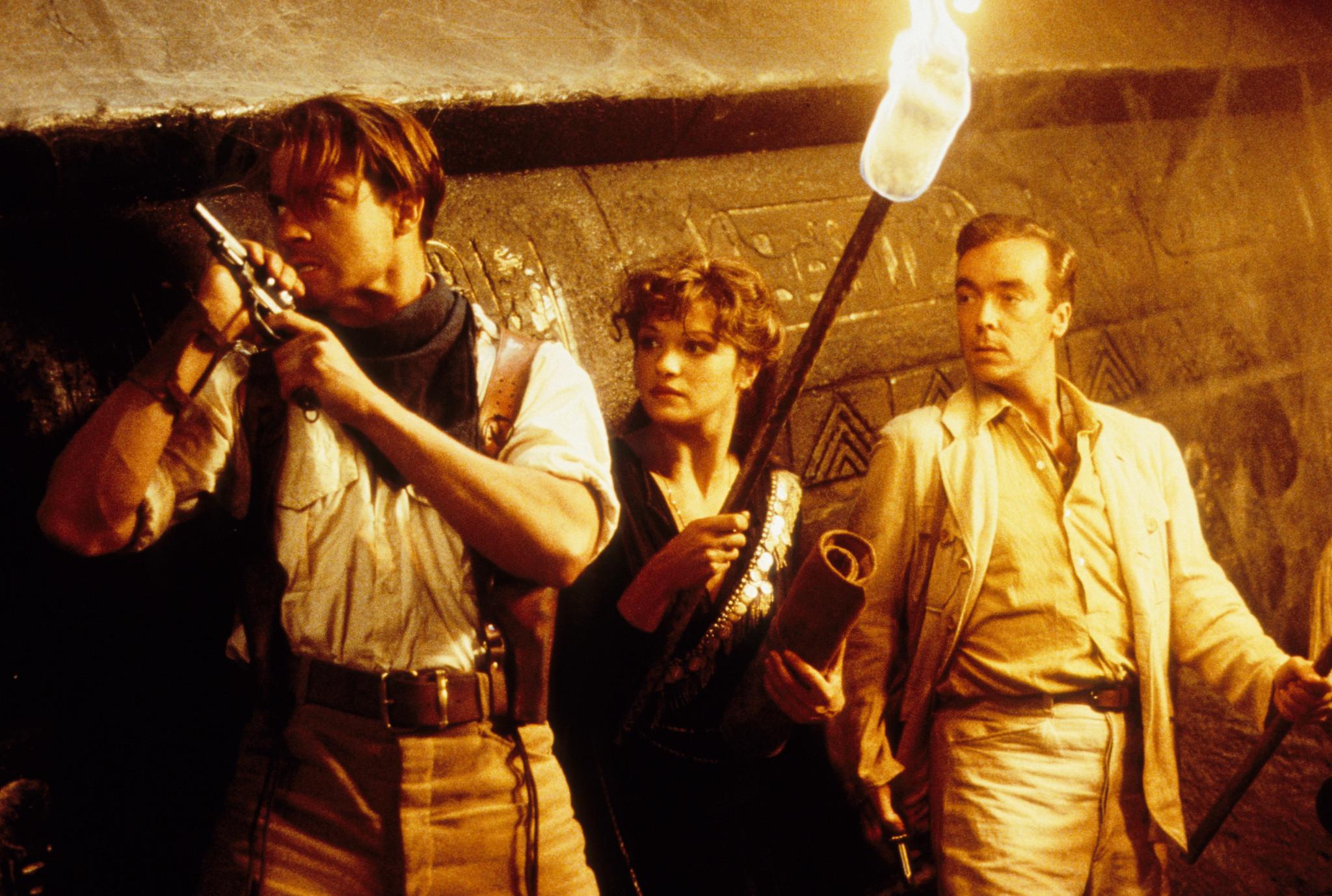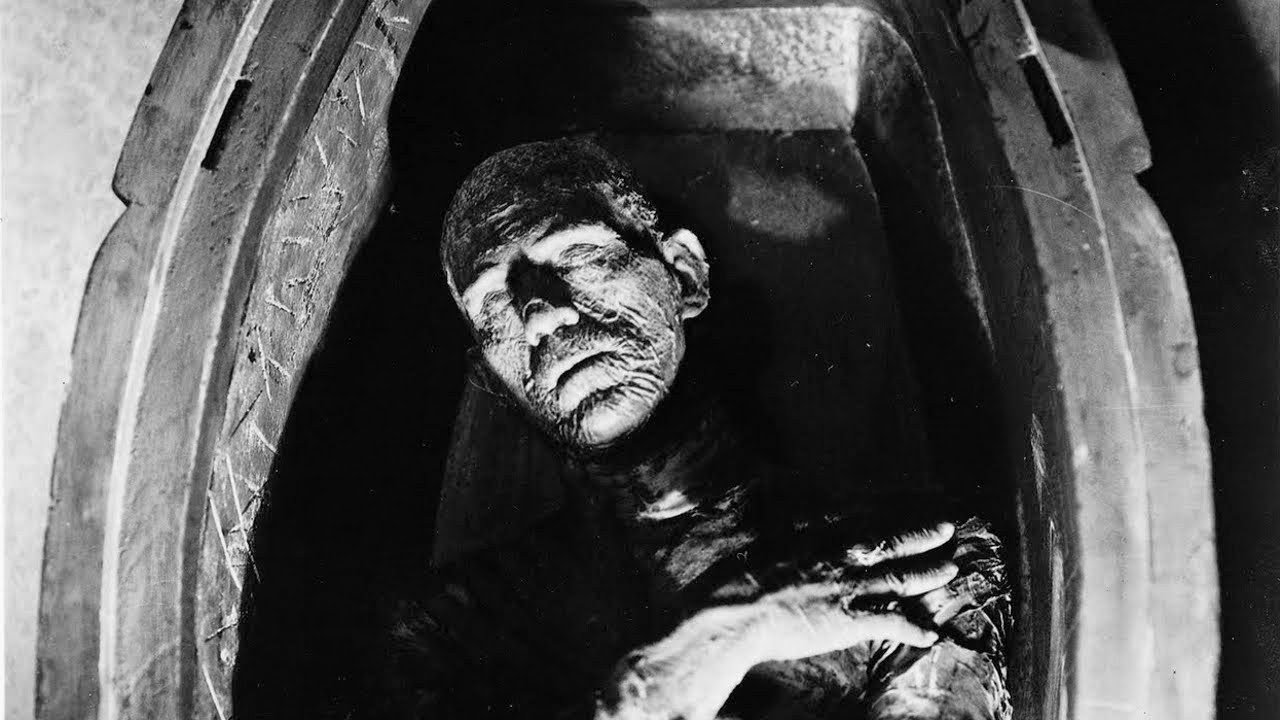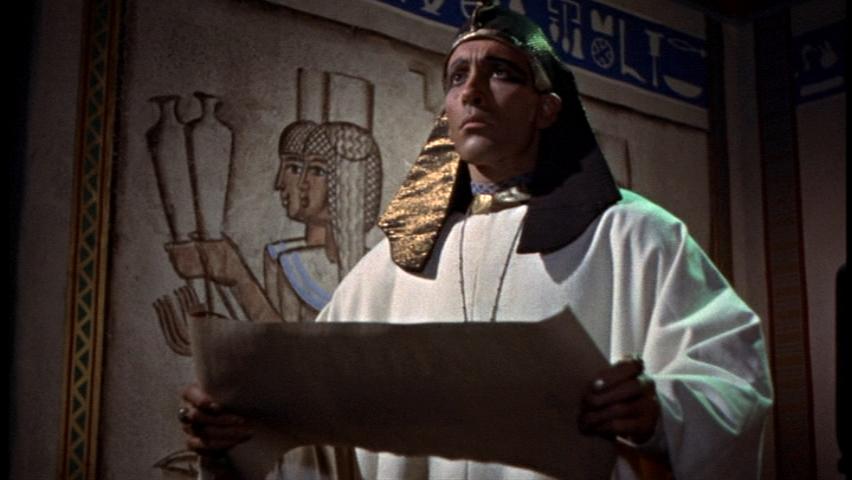7. Curse of the Mummy’s Tomb (1964, Michael Carreras)

“You cannot run away from the curse of the mummy’s tomb!!” this is quite true, especially in a scenario involving an unwitting team of explorers, the Egyptian desert and the Pharaoh Ra-Antef. Naturally the Pharaohs’ tomb is stumbled upon, but this time the Ancient Ones’ sarcophagus gets sold to a brash American showman, Alexander King (Fred Clark), for displaying in London.
Much of the film goes by without a mummy shuffling about at all, but when it is revived, it creates the customary chaos, leading to an excellent finale in the dank murk of the sewers of London. Clark plays the American showman as heavy handed as possible, eating up the rest of the cast, and Terence Morgan is an Egyptologist who harbours a surprising secret.
The film doesn’t hold up to the glorious sweep of colours found in Terence Fisher’s The Mummy (1959) and because it lacks any of its usual stars (apart from ever reliable Michael Ripper) it doesn’t quite feel like a full blooded Hammer production, the only sign it is, comes from a few gory limb removals and stabbings. Every time the film builds up some speed, it cuts to a flashback, and therefore removing any sort of suspense. The overdubbing of Jeanne Roland’s voice, with a heavy French accent, is also a distraction.
Appearing under an archway at the top of some fog heavy steps, the mummy is first seen as alive. It’s a great scene, drenched in atmosphere, and the film picks up considerably from here. But overall the whole film is let down by flat direction, as if Carreras had been roused from a long slumber himself, only stretching out the creaks and blowing off the dust in the final, tremendous 20 minutes.
6. The Mummy’s Tomb (1942, Harold Young)

“Eyes That Crawl With Madness! Hands That Creep Like Cobras!” Rarely does a film live up to its tagline when it’s this good. And sadly, yes, we’re in Universal sequel territory and by the 40’s; it seems they had all but given up on actually making them any good. Apart from a few exceptions, they all meandered through their 60 minutes (or thereabouts) and into the sands of time.
The story of Kharis is often repeated in these films, and here it is again, along with over 10 minutes of re-used footage from The Mummy’s Hand (1940) to bolster the tale. The mummy (Lon Chaney Jr) is brought back from a, no doubt, peaceful afterlife, to enact revenge on the Banning Expedition. The plot is much the same as the others in the series, a complete mess. But it’s helped by…uh hum…quotable lines such as this-Sherriff: “Whether you can believe it or not, the facts are here and we’ve got to face them. A creature that’s been alive for over 3,000 years is in this town.”
The atmosphere is great, moody scenes with the mummy and Mehemet Bay together, over a steaming Tana leaf broth and a fevered flame, as Bey gives his orders to Kharis “There’s death in the night air. Your work begins.” And the cemetery is suitably crooked and gothic. Make up virtuoso Jack Pierce’s mummy creation is first rate, with gruesome little touches added and the finale is fiery and memorable. Just a bit more TLC to these films, and they would be remembered more fondly.
5. The Mummy (1999, Stephen Sommers)

Or Indiana Jones meets The Mummy. Taking away much of the suspense for high adventure, this successfully updates the mummy for the modern times. Gone is the antique, brittle mummy of old, and replaced by a more vigorous Imhotep. All coated with a thick gooey layer of humour, which works on the whole, but tires as the film canters along.
Imhotep and Anck-su-Namun are lovers, but their burgeoning passion is forbidden, mainly by Pharaoh Seti-I. The Pharaoh is assassinated by Imhotep and escapes whilst Anck-Su-Namun, on the promise of resurrection, kills herself. The resurrection does not go as initially planned, and Imhotep is buried alive, with a nasty little scarab beetle for company.
Enter Indiana….uh…Rick O’Connell (Brendan Fraser), an adventurer, who strikes a deal with budding Egyptologist Evelyn (Rachel Weisz) and her brother Jonathan (John Hannah) to lead them to the City of the Dead where Imhotep resides, waiting to return.
Creatures, plagues and falling monuments spice the action up, and it’s always enjoyable, and thankfully, as something that doesn’t take itself too seriously, it doesn’t take too much inspiration from previous mummy “comedies” (Abbot and Costello) although Weisz is content to bumble along, occasionally uttering the odd loud squeak whenever something unsavoury appears, and the mummy, played by Arnold Vosloo, is suitably intense, but a lot less memorable than that old shambling romantic Karloff.
4. The Mummy’s Shroud (1967, John Gilling)

If Michael Myers were wrapped in streams of woven bindings and haunted Cairo instead of Haddonfield then it would resemble the mummy from this Hammer production. With more imaginative kills than your average slash-a-thon, including head crushing’s and acid attacks, it’s certainly gorier than any mummy film that’s come before it, and it’s certainly needed!
Prem, the title character, was a guardian to the young Prince Kah-To-Bey, and when Bey’s father dies, they escape to the desert, where Kah-To-Bey perishes. Seemingly protecting the boy in death as well as in life, now in 1920, he rises after a sacred oath (the secret words of life and death) is chanted, and goes on the hunt for the members of the expedition. Andre Morell, playing the scientist Sir Basil Walden does a fine, but uninspired job (his best performance, playing Watson in Hammers the Hound of the Baskervilles (1959)) and John Phillips as Stanley Preston, a gruesome, glory hunting business man, who you really do want to see get his comeuppance.
The last film by Hammer to be made at Bray studios, this retains the classic look and feel of previous Hammer productions, with deep, thunderous colours saturating the screen and giving it a much glossier look than its budget would allow (allow the thin funds are made apparent in the prologue). The mummy make up isn’t the best it’s ever been, but it’s effectively unemotional and menacing all the same, giving Prem the air of a casual, apathetic serial killer. But enjoy the Hammer mummy while you can, the next in the series Blood from the Mummy’s Tomb (1971) would feature a totally unwrapped mummy!
Watch it on a double bill with Frankenstein Created Woman, originally as it was presented.
3. The Mummy (1932, Karl Freund)

Dracula in bandages! For a brief couple of scenes at the beginning of this film Boris Karloff creates such an immortal image that the rest of the film struggles somewhat under the weight of it. What follows is a retelling of Dracula (1931) but told in a much more fluid style, utilising director Karl Freund’s background in German expressionism, and forgoing the static, stagey direction of Dracula, to create a much more rewarding film.
Karloff plays Ardath Bey/Imhotep, and in them iconic first scenes, he is disturbed by a young archaeologist who reads aloud life administering words from an ancient scroll, and is promptly sent insane when the mummy awakens and straggles off out of the door. Ardath Bey, now suitably clothed in fez and gown, and slightly less decomposed, scours Cairo for the reincarnation of his beloved Ankh-es-en-amon.
The film tries and succeeds for full throated horror at first, but then settles for an aching romance, as the lifelessly frail Bey pursues Helen Grosvenor (Zita Johann), his eyes losing that dead stare upon seeing her, with intentions of mummifying her, resurrecting her and claiming her as his own.
Sometimes plodding, but thick with atmosphere and otherworldly trips into real macabre territory, this does better than Tod Browning’s Dracula in telling the story of ancient love being grasped at from the grave.
2. The Mummy’s Hand (1940, Christy Cabanne)

This mummy means business! 8 years after Karloff immortalized the mummy Ardath Bey in a very brief, but memorable scene, Universal sought to resurrect this creature (albeit with a different name) from the sand swept depths, given a budget more slender than Ardath himself, they created The Mummy’s Hand.
The plot would now remain pretty much the same for future mummy films of the 40’s with only a location change and different actors to distinguish them apart. But what makes The Mummy’s Hand stand out is its vibrancy; it zips along at a great pace, with Tom Tyler as Kharis, buried alive and rendered mute by the removal of his tongue, then resurrected by the use of the trusted Tana leaves. His eyes are dead behind the twists of bandages and he is ferocious in the dispatching of his foes, eternally bound on a mission to kill!
Mad High Priests rule these films and George Zucco has to be mentioned for relishing the role and playing it to its insane maximum perfectly, and with an endless supply of Tana leaves, he manipulates the mummy to do his evil work. In an effort to become immortal, he uses the mummy to kidnap the object of his desires Marta (Peggy Moran), so they can both drink the Tana broth and live out…um…happily (?) for the rest of their days.
Brutal scenes ensue as the mummy rampages, making the last half of the film distinctly different from the first. Early scenes featuring bumbling archaeologists are played for laughs, but later, in the camp, with his cold, black pits for eyes, his presence is genuinely ghoulish.
If the films to follow weren’t so thrown together, then the mummy would be more regarded amongst Universals more memorable monsters, Kharis in The Mummy’s Hand is certainly more frightening than Lugosi’s suave Count…or, again, Lugosi’s sad, awkwardly elderly attempt at Frankenstein’s creation three years later.
1. The Mummy (1959, Terence Fisher)

After conquering with the claret sodden take on Frankenstein and their highly charged Dracula, Hammer studios turned their attention to that other Universal monster, the terminally unloved Mummy. Injecting it with full blooded colour and giving life to a rotting series of films. Adding Peter Cushing and Christopher Lee as John Banning and Kharis, and keeping the vengeance seeking, fez wearing disciple of the mummy intact from the Universal pictures, they produced another classic.
Banning, his father and his team open the tomb of Princess Ananka, ignoring a warning from a man named Mehemet Bey (the fez wearing disciple). Banning’s father enters, but is found delirious and unable to relay whatever had made him catatonic, and back home, is consigned to an asylum. We find, 3 years later that Banning’s father had read from the Scroll of Life and brought back Kharis, and now Kharis is intent on killing Banning and his team, for the defilement of Ananka’s tomb.
Terence Fisher, here proving himself a master of colour, swirls a palette of vivid Egyptian tombs and crimson swamps to unforgettable and striking effect. Dario Argento would up the ante with his use of rich slabs of colour in the late 70’s, but here, Fisher lets the viewer sink into it. Especially in the flashback sequence, as Kharis is consigned to his tomb, the door closing as greens, turn to red, then purple then black.
Lee is restricted to acting with his eyes, and we see expression burning in them. His mummy is more powerful and robust than the decaying Chaney Jr mummies of old, and Cushing brings his customary energy and professionalism to the role, with George Pastell, carrying on in the George Zucco tradition, as Mehemet Bey.
Universal may have THE iconic image of the mummy, but this film stands tall as its window crashing, tongue snipping successor.
Author Bio: Daniel Evans is a former art student, and writes mainly for his own entertainment. He developed a keen interest in film at a young age, and continues to unearth new, obscure movies when he can.